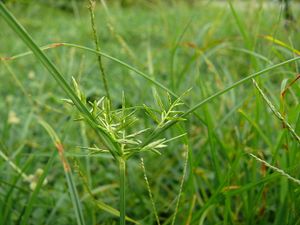Note: This is a project under development. The articles on this wiki are just being initiated and broadly incomplete. You can Help creating new pages.
Difference between revisions of "Cyperus rotundus - Mustaka"
| Line 1: | Line 1: | ||
| − | [[File:800px-Cyperus rotundus - Kourou.jpg|thumb| | + | [[File:800px-Cyperus rotundus - Kourou.jpg|thumb|right]] |
| − | + | ||
'''Cyperus rotundus''' is a perennial plant, that may reach a height of up to 140 cm (55 inches). The names "nut grass" and "nut sedge" – shared with the related species Cyperus esculentus – are derived from its tubers, that somewhat resemble nuts, although botanically they have nothing to do with nuts.The root system of a young plant initially forms white, fleshy rhizomes, up to 25 mm in dimension, in chains. Some rhizomes grow upward in the soil, then form a bulb-like structure from which new shoots and roots grow, and from the new roots, new rhizomes grow. Other rhizomes grow horizontally or downward, and form dark reddish-brown tubers or chains of tubers. | '''Cyperus rotundus''' is a perennial plant, that may reach a height of up to 140 cm (55 inches). The names "nut grass" and "nut sedge" – shared with the related species Cyperus esculentus – are derived from its tubers, that somewhat resemble nuts, although botanically they have nothing to do with nuts.The root system of a young plant initially forms white, fleshy rhizomes, up to 25 mm in dimension, in chains. Some rhizomes grow upward in the soil, then form a bulb-like structure from which new shoots and roots grow, and from the new roots, new rhizomes grow. Other rhizomes grow horizontally or downward, and form dark reddish-brown tubers or chains of tubers. | ||
| Line 6: | Line 6: | ||
Cyperus rotundus improves lactation, relieves fever, burning sensation, excessive thirst. Commonly known as '''nut grass''', it is also used in treating diarrhea, dyspepsia, herpes and more. | Cyperus rotundus improves lactation, relieves fever, burning sensation, excessive thirst. Commonly known as '''nut grass''', it is also used in treating diarrhea, dyspepsia, herpes and more. | ||
| + | |||
| + | [[Category:Herbs]] | ||
Revision as of 09:46, 12 October 2016
Cyperus rotundus is a perennial plant, that may reach a height of up to 140 cm (55 inches). The names "nut grass" and "nut sedge" – shared with the related species Cyperus esculentus – are derived from its tubers, that somewhat resemble nuts, although botanically they have nothing to do with nuts.The root system of a young plant initially forms white, fleshy rhizomes, up to 25 mm in dimension, in chains. Some rhizomes grow upward in the soil, then form a bulb-like structure from which new shoots and roots grow, and from the new roots, new rhizomes grow. Other rhizomes grow horizontally or downward, and form dark reddish-brown tubers or chains of tubers.
It prefers dry conditions, but will tolerate moist soils, and often grows in wastelands and in crop fields.
Cyperus rotundus improves lactation, relieves fever, burning sensation, excessive thirst. Commonly known as nut grass, it is also used in treating diarrhea, dyspepsia, herpes and more.
